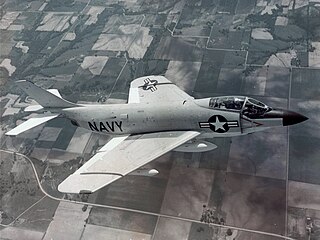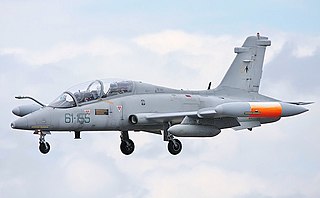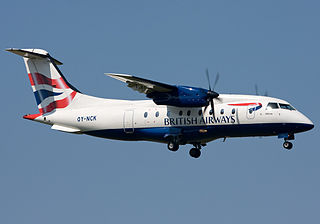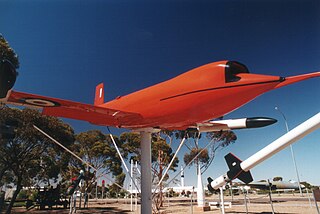
The AIM-120 Advanced Medium-Range Air-to-Air Missile, or AMRAAM, is an American beyond-visual-range air-to-air missile (BVRAAM) capable of all-weather day-and-night operations. Designed with a 7-inch (180mm) diameter form-and-fit factor, and employing active transmit-receive radar guidance instead of semi-active receive-only radar guidance, it has the advantage of being a fire-and-forget weapon when compared to the previous generation Sparrow missiles. When an AMRAAM missile is launched, NATO pilots use the brevity code Fox Three.

The McDonnell F3H Demon was a subsonic swept-wing United States Navy carrier-based jet fighter aircraft. The successor to the F2H Banshee, the Demon was redesigned with the J71 engine after severe problems with the Westinghouse J40 engine that was part of the original design but ultimately abandoned. Though it lacked sufficient power for supersonic performance, it complemented daylight dogfighters such as the Vought F8U Crusader and Grumman F11F Tiger as an all-weather, missile-armed interceptor until 1964.

The Advanced Short Range Air-to-Air Missile, also known by its United States identifier AIM-132, is an imaging infrared homing air-to-air missile, produced by MBDA, that is designed to dominate the within visual range combat mission. It is currently in service in the Royal Air Force (RAF) and Royal Australian Air Force (RAAF), replacing the AIM-9 Sidewinder. ASRAAM is designed to outrange and outrun any other IR missile in service, allowing the pilot to fire and then turn away long before the opposing aircraft can close for a shot. It flies at well over Mach 3 to ranges as great as 50 kilometres (31 mi), considerably over double the range of earlier designs. It retains a 50 g manoeuvrability provided by body lift technology coupled with tail control.

The BAE Systems Hawk is a British single-engine, jet-powered advanced trainer aircraft. It was first flown at Dunsfold, Surrey, in 1974 as the Hawker Siddeley Hawk, and subsequently produced by its successor companies, British Aerospace and BAE Systems, respectively. It has been used in a training capacity and as a low-cost combat aircraft.

The Nanchang Q-5, also known as the A-5 in its export versions, is a Chinese-built jet ground-attack aircraft capable of supersonic speed in level flight, which is similar to its predecessor Soviet MiG-19. However, the aircraft is predominantly flown at subsonic speeds due to its primary role being close air support.

The Aermacchi MB-339 is a military jet trainer and light attack aircraft designed and manufactured by Italian aviation company Aermacchi.

The Vympel K-13 is a short-range, infrared homing air-to-air missile developed by the Soviet Union. It is similar in appearance and function to the American AIM-9 Sidewinder from which it was reverse-engineered. Although it since has been replaced by more modern missiles in frontline service, it saw widespread service in many nations.

The Dassault/Dornier Alpha Jet is a light attack jet and advanced jet trainer co-manufactured by Dassault Aviation of France and Dornier Flugzeugwerke of Germany. It was developed specifically to perform the trainer and light attack missions, as well as to perform these duties more ideally than the first generation of jet trainers that preceded it. Following a competition, a design submitted by a team comprising Breguet Aviation, Dassault Aviation, and Dornier Flugzeugwerke, initially designated as the TA501, was selected and subsequently produced as the Alpha Jet.

The Soko J-22 Orao is a Yugoslav twin-engined, subsonic ground-attack and aerial reconnaissance aircraft. It was built by SOKO in Yugoslavia and by Avioane Craiova as the IAR-93 Vultur in neighbouring Romania.
The AIM-82 was a missile planned by the US Air Force but cancelled before any prototypes were built.

The AIM-97 Seekbat or XAIM-97A Seek Bat was a long-range air-to-air missile developed by the United States. It was intended to counter the perceived capabilities of the Mikoyan-Gurevich MiG-25 and proposed to arm both the F-15 Eagle and F-4 Phantom, the missile ultimately never entered service.

The AIM-95 Agile was an air-to-air missile developed by the United States. It was developed by the US Navy to equip the F-14 Tomcat, replacing the AIM-9 Sidewinder. Around the same time, the US Air Force was designing the AIM-82 to equip their F-15 Eagle, and later dropped their efforts to join the Agile program. In the end, newer versions of Sidewinder would close the performance gap so much that the Agile program was cancelled.

The Dornier 328 is a turboprop-powered commuter airliner. Initially produced by Dornier Luftfahrt GmbH, the firm was acquired in 1996 by Fairchild Aircraft. The resulting firm, named Fairchild-Dornier, manufactured the 328 family in Oberpfaffenhofen, Germany, conducted sales from San Antonio, Texas, United States, and supported the product line from both locations. A jet-powered version of the aircraft, the Fairchild Dornier 328JET, also is produced.

The Banja Luka incident on 28 February 1994, was an incident in which six Republika Srpska Air Force J-21 Jastreb single-seat light attack jets were engaged, and four of them shot down, by NATO warplanes from the United States Air Force. U.S. F-16 fighters southwest of Banja Luka, Bosnia and Herzegovina successfully engaged and destroyed several Bosnian Serb warplanes which had attacked a Bosnian factory, while suffering no casualties of their own. It marked the first active combat, air-to-air or otherwise, in NATO's history.

The GAF Jindivik is a radio-controlled target drone produced by the Australian Government Aircraft Factories (GAF). The name is from an Aboriginal Australian word meaning "the hunted one". Two manually-controlled prototypes, were built as the GAF Pika as a proof of concept to test the aerodynamics, engine and radio control systems, serialled A92-1/2, 'B-1/2'. The radio-controlled Jindivik was initially designated the Project B and received serials in the A93 series. Pika is an Aboriginal Australian word meaning flier.
Diehl Defence GmbH & Co. KG is a German arms manufacturer and a subsidiary of the Diehl Stiftung with headquarters in Überlingen. Diehl Defence mainly produces missiles and ammunition. Diehl BGT Defence was founded in 2004 as result of the merger of Bodenseewerke Gerätetechnik GmbH and Diehl Munitionssysteme GmbH & Co. KG. Diehl BGT Defence and Diehl Defence Holding are merged into Diehl Defence in February 2017.

The Short Range Air-to-Air Missile, or SRAAM, was an experimental British infrared homing air-to-air missile, developed between 1968 and 1980 by Hawker Siddeley Dynamics. It was designed to be very manoevrable for use at short range in a dogfight situation. SRAAM was unusual in that it was launched from a launch tube instead of being attached to a launch rail, allowing two to be carried on single mounting point.
The Diamondback was a proposed nuclear-armed air-to-air missile studied by the United States Navy's Naval Ordnance Test Station during the 1950s. Intended as an enlarged, nuclear-armed version of the successful Sidewinder missile, Diamondback did not progress beyond the study stage.



















